The European Refining Blues
Posted by JoulesBurn on June 22, 2012 - 12:43pm
This is a guest post by Stephen Bowers (TOD user carnot) who works for Evonik, a major chemical company based in Germany. Stephen is a petroleum chemist with over 30 years experience and started his career as a mud logger drilling oil wells.
Oil refining in Europe enters a new phase as the combination of emissions legislation and dieselisation of transport fuels demand really starts to bite. In the past months we have seen the rather muted bankruptcy of a major independent refiner, Petroplus, which was set up in the last decade by one Thomas O'Malley, who had previously set up the independent and very successful refining group Valero. Petroplus, it would appear, tried to emulate the strategy of Valero, and in Europe purchased 7 refineries of rather mixed capabilities at relatively low cost: two in France (ex Shell), two in the UK (ex BP and Phillips), one in Germany (ex Exxon), one in Belgium, and one in Switzerland. By the time of the bankruptcy announcement Petroplus had shuttered two of the refineries: one in the UK and one in France.
How did it all unravel?
In this article, the changing landscape experienced by European refiners will be explored to help understand how a business that was profitable a few short years ago became much less so.
A New Market Environment in Refining
In 2005, refining had become suddenly profitable, and refining oil had thrown off the decades trend of low margins and the emergence of capacity limitations and strong end use demand had turned it into a a money maker. I remember going to several refining conferences in 2005 and I noticed an unduly large number of investment bankers and finance types in the audience - nouveau experts in refining finance. Whispers were heard at lunch of, "How about locking in that refining margin profit?" When they found out that I did not actually work for a refinery, the suits moved on to find someone who did. It was almost surreal watching these financiers circle and entrap their prey; a bit like bloodsucking leeches in a jungle.
Total produced this slide at the European Refining Conference that was held recently in Paris. Units are in $/mt. To convert to barrels divide by 7.3. You do not need much of a calculator to work out that the margin is 2-3% of the crude price: thin to non-existent. See Figure 1:
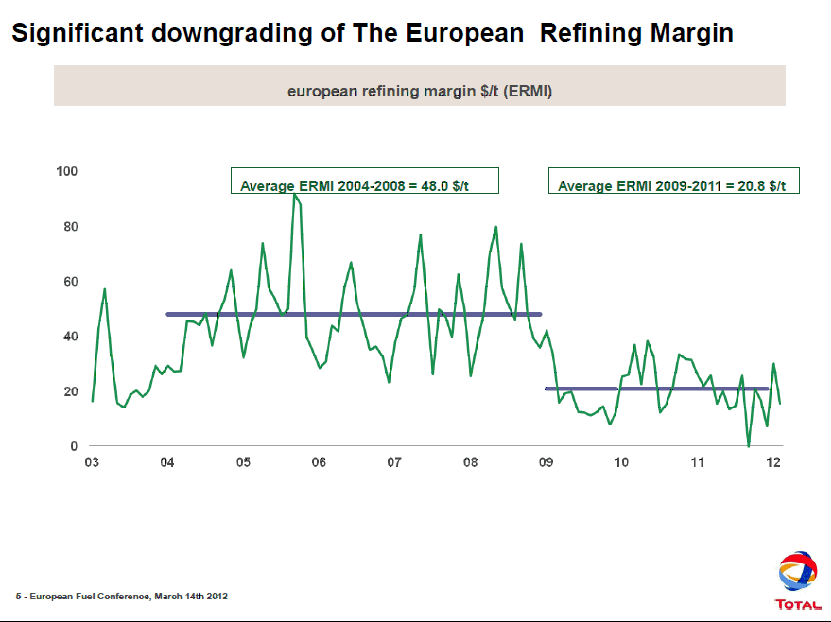
|
Figure 1: European Refining Margins |
Meanwhile, a few wily refiners decided to cash-up by doing a bit of housekeeping. BP and Shell managed to off-load a number of not so good assets to debt financed buyers who, like lambs to the slaughter, thought the good times were here to stay. Then in 2008 the wheel came off the wagon and margins fell back to the long-term trend, but meanwhile, the price of oil had doubled. Needless to say, many of the new guys found that oil refining was not so easy after all. The ever publicity seeking Sir Richard Branson of Virgin Group fame, not one to miss any opportunity for self- aggrandizement, duly announced that it was time to buy an oil refinery, and take on the big boys at their own game. He must have wised up because like a lot of his ideas, it came to zippo and he probably saved himself a fortune.
As I complete this article, we have several recent sales of refining assets both side of the Atlantic. Gunvor purchased the Petroplus Antwerp refinery and Vitol-Atlasinvest have purchased the Cressier Switzerland refinery. Neither of these assets are outstanding. Meanwhile, Delta (of airline fame) has purchased the Conoco Phillips Trainer Refinery via their Monroe subsidiary. Carlyle are in talks to purchase the Sunoco Philadelphia refinery. I would not count either of these refineries as outstanding and despite Delta's claims that they will save $300 million per year by investing $100 million (+ purchase price of refinery) to maximise jet fuel production, I remain somewhat sceptical for this reason: to save $300 million on 185 kbd per day would imply a margin increase of $4.43 per barrel. If it were that easy, why has Conoco not already done it? The payback would be in four months. Alas, Delta is in dream land. The refinery capacities are in the table extracted from the Oil and Gas Journal Refinery survey January 2012.
http://www.bloomberg.com/news/2012-04-30/delta-air-said-to-near-accord-t...
http://www.bloomberg.com/news/2012-04-23/sunoco-in-talks-with-carlyle-on...
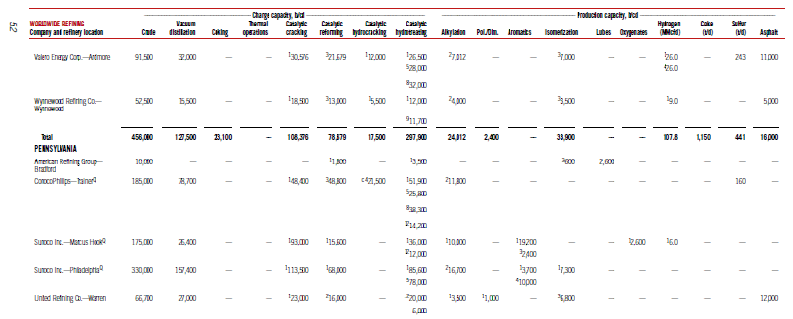
|
Table 1: Pennsylvania Oil Refineries and capacities (click image for more readable version) |
The Influence of Biofuel Mandates
About the same time as the refining margins peaked, Europe got "biofuel fever". The old arguments surfaced. Climate change, energy independence, carbon emissions, green transport, but no mention of Peak Oil anywhere in sight. The farm lobby was not slow to catch on, and we saw a massive push to biodiesel followed by a later push to ethanol under the guise of the renewable transport fuel obligations (RTFO). Biodiesel was competitive with mineral diesel we were told. Well fools and their money are soon parted, and investors large and small raced headlong into the shark-infested market of biodiesel. I remember in 2005 negotiating a tank storage deal with a long-term supplier. He was well pleased. He had signed a deal with a large biodiesel producer. I was intrigued. It was a 15-year deal and 250 kta throughput. Those are big numbers. I thought, What do these guys know that I don't? Am I missing something? I asked sort of matter of factly where the vegetable oil was going to come from. "Imported from wherever is cheapest," was the reply. "Really", I said. Good luck, I thought. My cynicism was not wrong. The shiny new state of the art biodiesel plant started up and then shut down, and then went bust, taking a lot of investors' money with it, and leaving Barclays bank with a shiny new unprofitable biodiesel plant (current European biodiesel capacity is about 20 million tonnes per annum - the actual production is not even half of that figure). This plant that ran up debts of over $158 million was disposed of for $15.8 million and its future is still unclear. So much for the 15-year storage contract. Well, currently mineral diesel nudges $1000 pmt and biodiesel is close to $1300 pmt, and as I write we continue to hear the cries of, "All we need is a subsidy, a mandate, or higher oil prices or better still all three, and we will be profitable." Well, it now looks as if they will have one wish granted as the EU RTFO (renewable transport fuel obligation) mandates 7% biodiesel into the diesel/gas oil pool, much to the chagrin of any driver who is wise enough to know that it is a truly lousy product and an even worse idea. Figure 2 demonstrates quite eloquently the capacity and production of European biodiesel. Only mandates are keeping biodiesel alive in Europe, paid for by the long suffering consumer at the pump. If we really have to use vegetable oils(or animal fats) in fuels, then hydrogenation is THE way to go without doubt. On a variable cost basis, there is little to choose between FAME and HVO. On quality and handling there is no comparison.
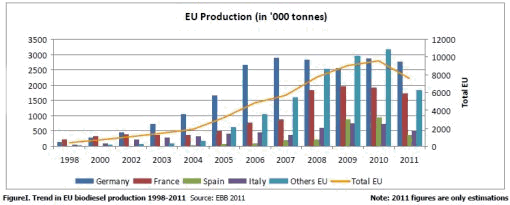
|
Figure 2: European Biodiesel Production and capacities Actual source here- http://www.ebb-eu.org/stats.php |
The ethanol lobby raced to catch up and now most of European gasoline has some ethanol blended into it, but it varies from country to country. The Germans, who like to think they are green, adopted a 10% ethanol requirement in gasoline in 2011 which went down like a Lead Zeppelin (as opposed to Led Zeppelin). German motoring organisation were up-in-arms and motorists shunned the new grade, paying over the odds to buy 98 octane super plus instead of 10% ethanol gasoline, and causing local fuel shortages of the premium grade that only made up 3% of normal sales. They, the Germans, were not going to use that "green fuel" in their pride and joy, and frankly I do not blame them.

|
Figure 3: EU projected light vehicle carbon emissions and target Source: 3 Bhatt Meeting EU Standards 2010 |
Switch From Gasoline to Diesel
More pain was yet to come as the the high prices did, more than anything, modify consumers' habits. A steady shift away from gasoline vehicles to diesel, and improving technology has drastically reduced fuel consumption over the past decade in Europe. By 2020, the fleet average emissions target will be 95 g carbon dioxide per km, or at least that is what has been legislated. The penalty is a levy on every vehicle that exceeds the fleet average, based on its carbon emissions. Though only few cars can achieve this at present, there are more and more getting closer and closer. As a result it looks as if diesel demand is close to peaking and gasoline demand is in continuous slow decline decline. See the following slide, Figure 4 from Europia to explain this point.

|
Figure 4: EU gasoline diesel balance |
This can be seen in the sales of diesel cars in this slide Figure 5, again courtesy of Total.
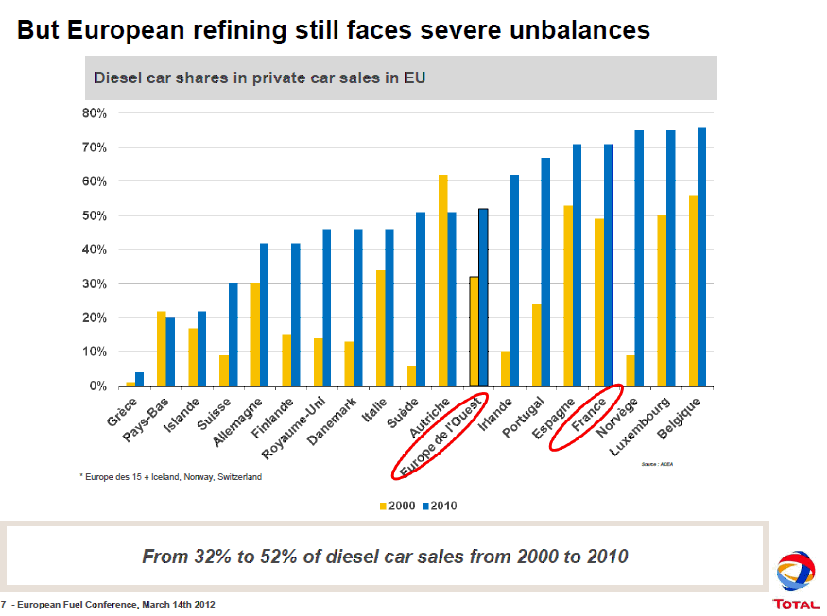
|
Figure 5: Distribution of Diesel- Gasoline vehicle sales in EU |
By 2011 the refining margins were also causing pain. Refinery sales, joint ventures, and closures were all on the cards. Re-incarnations were also possible as ConocoPhillips managed to sell the shuttered Wilhemshaven refinery to a Dutch Investor (good luck). Lyondell announced their 2007 acquisition Berre refinery was to close and Total closed one refinery and severely reduced capacity at another. Shell sold two more refineries, Stanlow and Heide, and announced the closure of Harburg. Ineos sold part of their Grangemouth refinery to Sinopec and Tamoil shut Cremona in Italy. Petroplus meanwhile shuttered Reichstett. Phew. We were not done yet. Valero bought the Chevron Pembroke refinery and Rosneft purchased the 50% share of Ruhr Oel that was owned by PDVSA. Total placed Lindsey oil refinery up for sale as did Murphy who put their Milford Haven refinery up for sale as it announced that it wanted to get out of refining. There is more, but I think most readers will get the idea - refining in Europe is not a good business. It never was a good business, and is never likely to be a good business.
The slide Figure 6 gives a snapshot of the situation but it is a moving target. Expect it to get worse, not better.
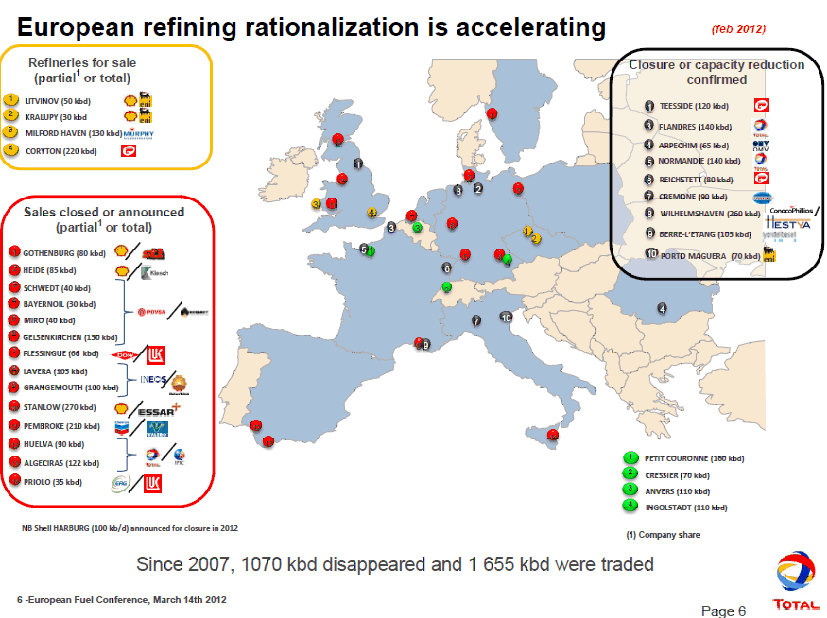
|
Figure 6: EU refinery sales and closures |
The Source of Pain for European Refining
What is wrong? What has happened? The malaise in European refining has not happened overnight. The reasons are deep rooted and come from a number of causes:
- Lack of profitability and therefore under-investment over decades
- High end use pricing due to taxation making up more than 50% of retail cost of transport fuels The refiners have been unpaid tax collectors.
- Changing fuel specification standards, especially with respect to sulphur and aromatics
- Change in product mix which does not now fit the historic refinery configuration
- Growing US gasoline exports making the European gasoline surplus more and more difficult to dispose of
- Biofuel blending especially with ethanol into the gasoline pool
- Carbon Emissions and ETS (emissions trading scheme)
Put together, the causes have made for a miserable 2011 and many refiners are either losing money or are barely profitable, and this is before they start paying for carbon emissions. See Figure 7 Courtesy of Europia.
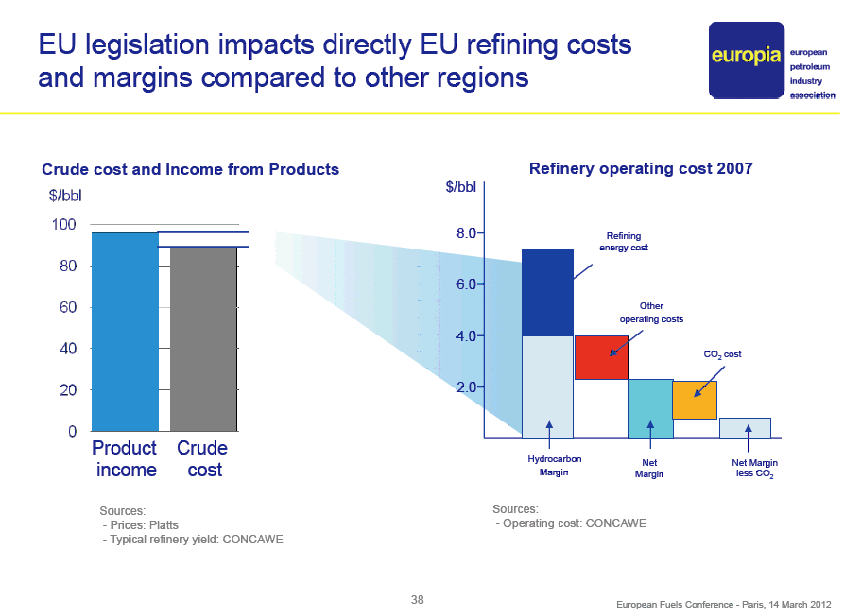
|
Figure 7: EU refining margin cost structure |
Figure 7 ably demonstrates the difficulty with refining margins. The gross refining margin is the product costs less the cost of crude and currently they range from $1-10 per barrel of crude processed, depending on the refinery. Out of the gross refining margin comes the energy costs and the fixed and variable costs, depicted above as the other operating costs. The fixed costs are wages and the like and the variable costs the catalysts and consumables to operate the refinery. What is left is the net cash margin which for this example is about $2 per barrel. As you will also see, energy is now making up a significant part of the cost structure. You do not have to be too clever to realise that with crude at $100 per barrel and something like 7% of the crude burned as energy, the cost per barrel processed is about $7 +/-. Further pain is about to be applied in Europe as the EU in all its wisdom moves towards charging for carbon emissions. Very roughly refiners will have to pay for about 30% of their emissions, the rest being covered by allowances. I am not against efforts to reduce carbon emissions, far from it, but this will be another nail in the coffin for European refiners and more and more fuels production will be off-shored. A prime example is India which is building refineries that will export finished fuels to Europe. India will import oil, refine it and sell it on and meanwhile claim that they should not be bound by carbon emission limits. Hmm, I am not sure if I buy into this. Likewise Saudi Arabia will be massively expanding its refining base, with some of the middle distillate product being targeted at Europe.
Diminishing Margins from Lower Product Sales Flexibility
It is worth noting where the money is made and where the money is lost, and the best way of demonstrating this is in the crack spread, that is the margin made or lost per barrel of finished product in relation to the crude oil price. The crack spread can be constructed for any crude oil if the price of the oil is known and the product prices are known. It is fairly obvious from the graph that if the oil barrel was refined into just jet-kerosene and diesel-gas oil then there would be a shed load of money to be made. But life is not that easy. Fifteen years ago a cocky young accountant said to me that my job marketing aromatics was easy. "Buy low and sell high. Nothing to it". My reply was simple. "There is the phone, show me how its done". He did not accept the challenge and then went on to work for EMI, who went bust (Ha, ha). Refining oil is a capital intensive volume business. Size matters in refining, but that is only part of it. When a barrel of oil is refined one only have limited control over the yield of each product. Though one might wish to produce only jet and diesel, you will not by choice also produce some LPG, naphtha, gasoline and fuel oil; that is the way it is. LPG is typically 3-5% but fuel oil can be 20-40% dependent on the crude, or even higher in a few cases. Minimising the fuel oil production has been a goal for some time and the results have been good in so much as there has been a downward trend in fuel oil production. This comes at a price as either the fuel oil is coked or hydrogen is added to improve its processability, known in the business as carbon out or hydrogen in which I will discuss later. See Figures 8 and 9 and Table 2 below.
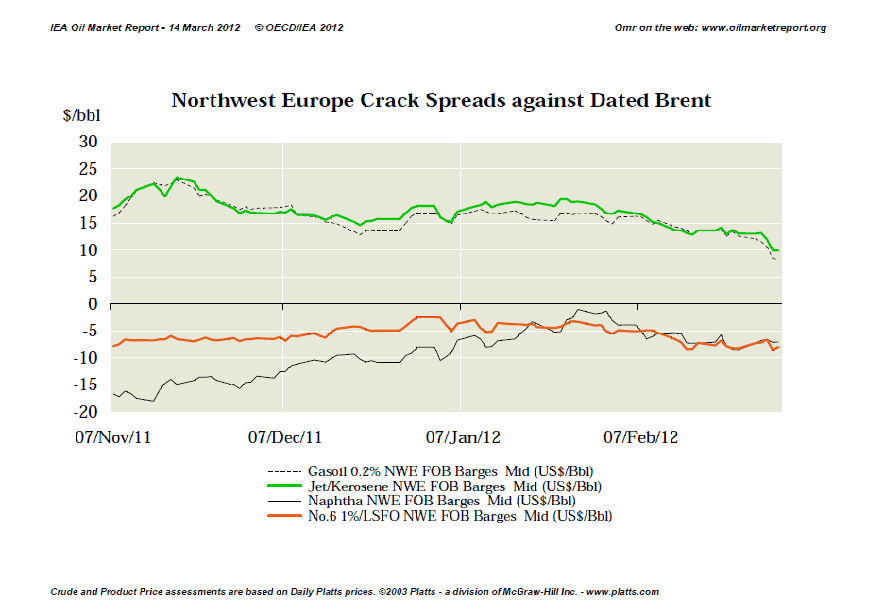
|
Figure 8: IEA OMR calculated crack spread published April 2012 |
For licensing reasons the IEA does not publish gasoline pricing in its crack spread model. See below for a fuller picture. Gasoline margins show the typical summer spike.

|
Figure 9: Brent Crack Spread for 2011 Source: Pricing data from Platts monthly averages |
Here is the crack spread for 3 well-known crudes for December 11 (2011)
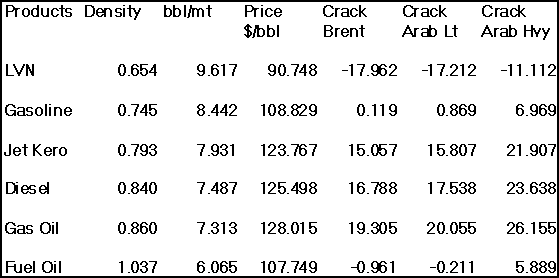
|
Table 2: Crack Spread for various crudes for Dec 11 Source data for Pricing is Platts and OPEC monthly bulletin. |
As can be seen, the margins are significantly better for Arab Heavy - but this excludes the higher cost of refining and the much more complex refinery that will be required to refine this oil; the crack spread does not reflect the yield. Naphtha was a loser for all crude types and gasoline was far from good. The middle distillate margins made the money. Up until about 2010, Europe relied on disposing of excess gasoline to the US, but that outlet is now closed as the US becomes long on gasoline (at least for the moment).
The common belief is that the light sweet crudes, such as Brent, carry premium prices, which in principle was true in the past but may not be the case now. In January this year, Saudi Aramco sold Arab Light to European customers at a minimal discount of $0.35 per barrel to the Brent price. Suddenly, a 32 API medium sulphur crude has become more valuable than a light 38 API sweet crude. It all comes down to the yield of middle distillates as opposed to light distillate. Naphtha has become a millstone in Europe as ethylene crackers have reduced rates and have looked at ways to increase feedstock flexibility. This has placed particular pressure on those refiners that did not have an in-house outlet for the light naphtha and sold it on the spot market to European crackers. Much of the light naphtha has relatively poor characteristics for gasoline blending and refiners do not want to depress the gasoline price any further. Moreover our new found love affair with ethanol has reduced blending options still further, even putting pressure on iso-pentane blending (C5 isomerate). The obvious way out is therefore to process crudes with less light naphtha and gasoline components and Aramco has not missed this point. In my refinery model in all cases Arab Light crude produces the same or better refining margins than Brent in the EU. See Figure 10:
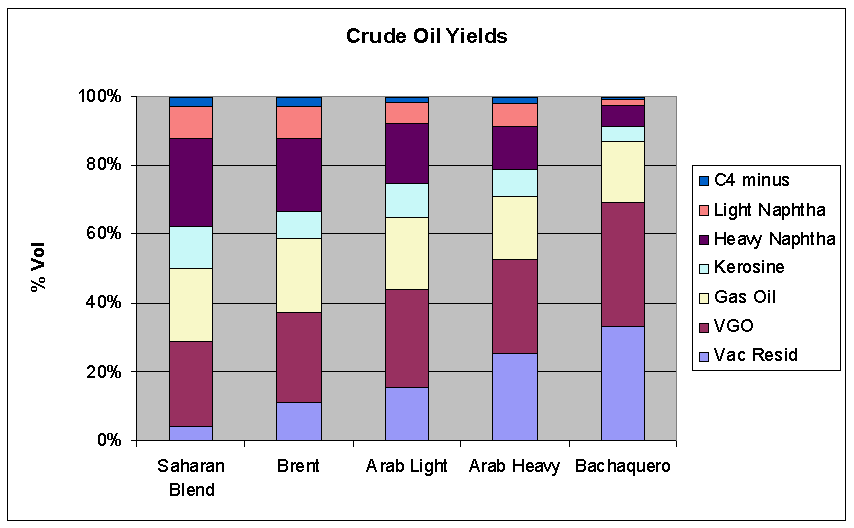
|
Figure 10: Crude Oil Yields Source: Modern Petroleum Technology - Institute of Petroleum |
For comparative purposes, the Atmospheric Residue or reduced crude is the sum of the VGO and Vac Resid. The sum of kerosene and gas oil make up the middle distillate fraction. This table is representative of the yields after atmospheric and vacuum distillation and before further processing.
With current trends, things will not change any time soon and they could possibly get worse. Several years back the UK Energy Institute magazine ran an editorial that 30% of the European refining capacity could be threatened within the next five years. Few readers took much notice and probably even fewer believed it. But there is little hope for optimism at the present time and the spectre of carbon emission fees might just be the tipping point that sends refiners to look elsewhere. Increasingly, it looks as if Europe will import more and more jet and diesel from the Russia, the Middle East, and India as politicians forge ahead with ill-conceived emission standards and renewable fuel policies in the misguided belief that this is the green way forward.
Static European Refinery Configurations
Looking into the European refining landscape as I do, one sees that the refining base is essentially 40 to 50 years old; past its best, to put it mildly. It expanded rapidly in the 1960s and 1970s and gasoline production was the order of the day, i.e. Fluid Catalytic Cracking and Alkylkation units, coupled with the ubiquitous catalytic reformer for aromatics and hydrogen production. A good example of this is in the diagram, Figure 11, below of the Petroplus Reichstett refinery, which was closed even before they were insolvent. The FCC is a carbon out conversion unit. Coke is deposited on the catalyst which is combusted to produce process heat in the regeneration step.

|
Figure 11: Reichstett Refinery "Classic EU configuration" Source: Petroplus website before insolvency. |
In the 1980s we saw a developing trend towards hydrocracking, and some (a handful) coker units were installed to help minimise fuel oil production. All hydrocrackers in Europe are operated in a middle distillate mode to maximise jet and diesel production. Only minimal gasoline is sought as hydrocrackate gasoline has a low octane number and must be blended with other high octane components. Hydrocrackate diesel and jet do not suffer from this problem and are excellent blend components. Figure 12 is the new configuration for the Repsol Cartegena refinery which has just had a major revamp with a new 100 kbd CDU, a 46 kbd Hydrocracker and a 53 kbd Coker. The original refinery was basic and uneconomic. $3.5 billion of investment will make this a refinery amongst the best in Europe and produce in excess of 50% of the crude charge as middle distillates, which is very impressive by any standard. Note there is no gasoline production in the new part of the refinery. This is a hydrogen addition and carbon rejection set-up. The hydrocracker adds hydrogen (hydrogen in) to the feedstock to saturate olefines formed during cracking and saturate the aromatic rings. Coking is a carbon rejection process that rejects carbon as coke in the residue processing step. The existing CDU is in the white box. Total CDU capacity will be 11 mt of 220 kbd, processing a medium heavy crude.
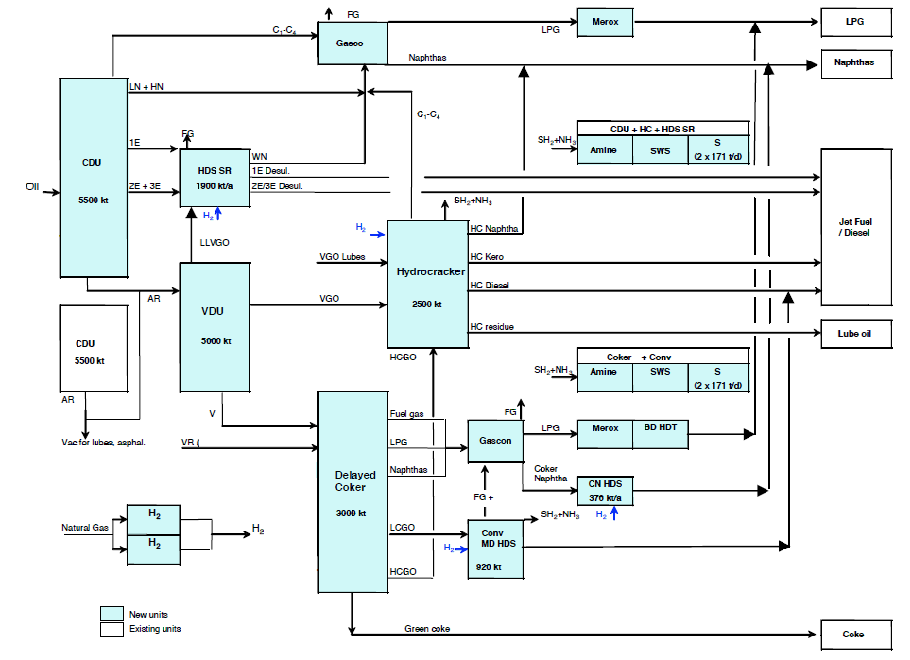
|
Figure 12: Repsol Cartegena Refinery Expansion Repsol Cartegena refinery expansion - Facing the Future of Refining Gonzalo 2008 |
More detail on the Cartegena expansion can be obtained here.
Link http://www.google.com/url?sa=t&rct=j&q=cartegena%20coker%20and%20hydrocr...
or
http://www.onepetro.org/mslib/servlet/onepetropreview?id=WPC-19-0256
This link costs $10, so try the other link first.
By reducing the hydrocracker severity, it is possible to reduce the hydrogen consumption. Another neat trick is to operate in an even milder mode, which allows a high throughput of vacuum distillate, some of which is merely hydrotreated and desulphurised and a product called unconverted oil (UCO) or hydrowax is produced. Hydrowax is essentially treated vacuum gas oil (VGO) and it can be used either as ethylene cracker feed or cracked in a Fluid Catalytic Cracker. In both cases the results are better than untreated VGO. It will also soon find an outlet in low sulphur marine diesel, due to tighter sulphur specifications for marine fuels.
When Hydrowax is used in an FCC there are a number of tweaks available. Turning the severity down produces a greater volume of light cycle oil (FCC diesel) which can be blended into the diesel pool. It is not the best quality but is a useful extender if blended with hydrocrackate diesel. Hydrowax cracks better because some of the aromatic rings are saturated to naphthenes which can then be opened by the FCC catalyst. Another option is to increase the FCC severity and overcrack to C3 and C4 olefines. The real clever approach is to do both. Shell has a FCC process called MILO which stands for Middle Distillate Light Olefines. In this process the severity of the FCC is low towards hydrowax which maximises LCO, and some of the FCC naphtha stream is recycled back for over-cracking to light olefines, hence the term MILO. There are a number of similar competing processes of this type, and FCC naphtha overcracking is becoming increasingly popular. This approach has been adopted at the new Saudi Aramco Total refinery that is being constructed in Jubail. See Fig 13.
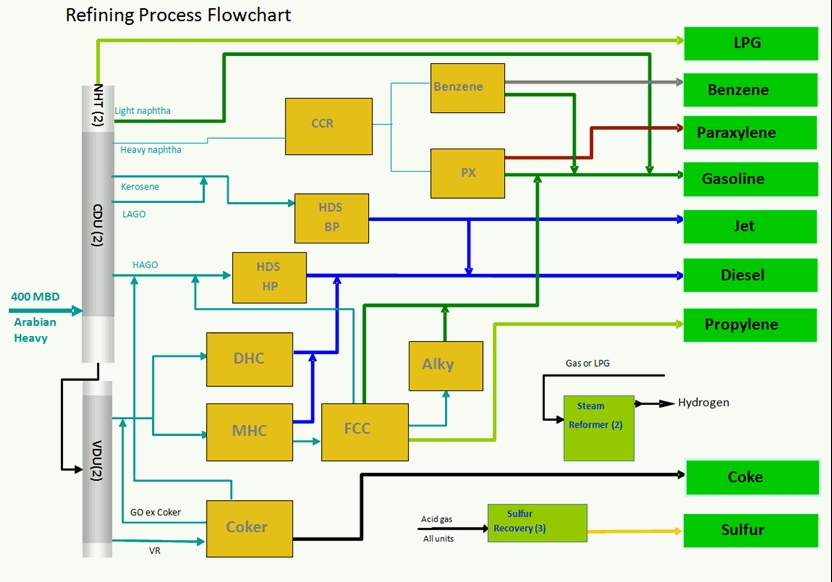
|
Figure 13: SATORP Refinery Source: SATORP website. |
This is a true state of the art refinery ($10+ billion price tag) and is optimised for the production of petrochemical intermediates and transportation fuels. It employs two hydrocrackers and a petrochemical FCC. The DHC is a distillate hydrocracker optimised for the production of diesel, and the MHC is a mild hydrocracker which is optimised to produce hydrowax feed for the FCC. This hydrocracker is effectively a feed pre-treatment unit. The propylene from the FCC will be something like 20% of the feed charge and there will be a similar amount of C4's which are sent to a sulphuric acid alkylation unit. The CCR is a platformer that will feed an aromatics plant for the production of benzene and para-xylene (PX). Para-xylene is the precursor for PTA- pure terephthalic acid which is used in PET resins - polyester. The delayed coker gets around the high conradson carbon in the crude charge (Manifa crude) which would be difficult and expensive to treat in any process other than carbon rejection. Conradson carbon is essentially the condensed hydrocarbon molecules that are primarily made up of asphaltenes. Coking is effectively the only option open due to the very high asphaltene content. In the longer term, my belief is that the light naphtha will be used as steam cracker feed in two units being planned next to the refinery. NHT refers to naphtha hydrotreater. See Table 3: Manifa SARA Assay from Aramco JOT spring 2012 p47 (SARA = saturates,aromatics, resins, asphaltenes) Note this is for the whole crude not the reduced crude.

|
Table 3: SARA for Manifa Crude Source data for Pricing is Platts and OPEC monthly bulletin. Link http://www.saudiaramco.com/en/home/news/publications-and-reports/saudi-a... |
The Foster Wheeler graphic, Figure 14, below summarises the options for residue conversion, based on Atmospheric Residue 343 deg C +
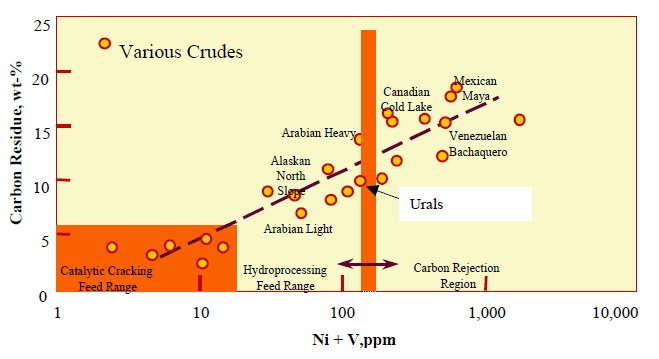
|
Figure 14: Options for Residue conversion Source Foster Wheeler ERTC paper 2002 Data form SFA Pacific http://www.fwcparts.com/publications/tech_papers/files/ERTC%202002%20-%2... |
Future Product Demand: Can Refineries Adjust?
In a presentation recently given by Europia (European Petroleum Industries Association) the fuel mix for 2007 was compared with that anticipated for 2030 in Europe. The projection is not at all comforting as the fuel pool will be made up of 60% middle distillates, gasoline making up less than 10% of the demand, and jet exceeding gasoline demand. How would this demand be fulfilled? Not with the existing assets that is for sure and there has to be an environment in the EU that encourages the refiners to invest in the necessary upgrades, similar to what Repsol has done in Cartegena. Figure 15 demonstrates the challenge.
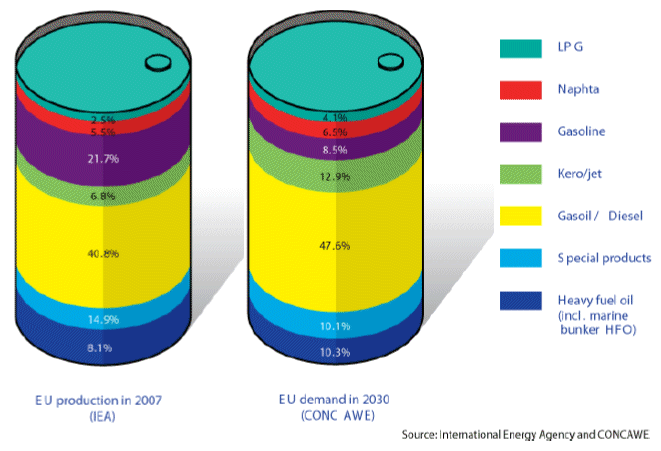
|
Figure 15: Actual and Projected EU product demand |
At the European refining conference in March 2012, the large European refiner Total revealed that they counted 28 million tonnes/annum (520 kbd) of Mild Hydrocracking capacity announced in the next 5-6 years with a likelihood that 80% of this capacity will be installed. No new FCC capacity will be installed and some FCC capacity reductions can be expected as where the VGO feed is mildly hydrocracked it reduces the available feed for the FCCU's. Reducing the feed flow to the FCC would allow a MILO type operation without having to invest in the FCC gas handling system i.e. light olefine production can be maintained as can a better quality LCO (FCC diesel) and FCC gasoline is reduced. A win-win approach. Moreover the FCC gasoline that is produced tends to have a higher octane number. This approach is the low-cost version compared to investing in a full blown Hydrocracker either with single stage recycle or two stages, which run at much higher pressures, and come with a hefty price tag. The problem is that most of the hydrocracker projects identified are not in Western Europe where most of the refining assets are but in Eastern Europe. As an EU citizen, I watch with amazement that Greece intends to build 2 hydrocrackers - with whose money I wonder? See Figure 16:

|
Figure 16: New EU DHC capacity |
This will give some relief to the refineries in the East, but those refineries in the West are not investing anywhere near fast enough and however one looks at the situation, closure of refining assets is the likely scenario. Moreover, what we are seeing in western Europe is the purchase of refineries by non-integrated, often opportunistic players, which is not likely to result in the investment needed to bring these assets up to a standard to compete. When, not if, these assets close, then they will be gone for good, as the likelihood of them ever starting up again will be remote. However, the longer these marginal assets continue to operate whilst burning money, then the longer and worse the pain will be on the rest. Maybe the BP and Shell exit strategies saved them money in the short term, but in the longer term it remains to be seen. The situation in the US is not much better. There are many US refining assets that are past their best, and though the situation is not as bad as in Europe, it can only be a matter of time. Maybe this is a story for another day.




Thanks for such a comprehensive benchmark review.
Regarding the biofuel excursion.
Biofuel except that from 'waste' materials in niche applications is a terrible idea environmentally.
There are even plans to burn world vegetable oil in the UK for power generation.
This stuff is not 'green' and is no answer to CO2 emissions.
As an ex-agricultural scientist I did a brief calculation in 2008 using ex-colleagues' numbers that showed that if the whole of a maximal possible crop of oil seed grown in the UK (thought experiment!) was used for diesel it would provide less than 6% of UK diesel demand. Biodiesel means large imports of vegetable oil for the UK. Also, with my background, I hate the idea of using wheat for ethOH motor fuel, and the net energy returns on that are ludicrous.
This map for UK biofuel refineries could do with an update: any ideas as to where this lot is going? http://www.biofuelwatch.org.uk/?s=refinery
Phil
My views on biofules are well documented on this site. I have yet to see a viable biofuel either economically or environmentally, the exception being waste oils and some other solid wastes, which under certain circumstances can provide a viable option of reuse. This includes biogas.
Removing biomass from the environment is a bad idea, and I positively cringe when I hear the word waste biomass. There is no such thing. Left alone biomass and the nutrients it contains is perfectly recycled by autotrophs and heterotrophs.
The so called second generation biofuels, eg cellulosic ethanol, will reek untold damage on the soil structure. Hopefully, due to the truly awful EROEI I doubt if they will ever be commercial on a lare scale.
I will have a look into the so called UK biorefineries but my guess is that most will be struggling. Biodiesel is not viable on a large sscale and ethanol from wheat cannot compete with other sources.
I think that labeling all biomass removal as a bad idea is a little too general. The forest industry has been harvesting trees for a long time without a loss of soil productivity. Conifers tend to have most of the nutrients in the needles, small branches, and root systems that are usually left on site during harvest operations. In addition, the annual needle drop provides plenty of opportunity for nutrient recycling.
With construction and development at reduced levels in many developed countries, a lot of woody biomass that previously went into producing lumber could be redirected to CHP and heating applications without a negative effect on the environment. In areas that have historically had a fire cycle, harvesting some of the trees represents an opportunity to capture potential energy that would otherwise just go up in smoke.
So how are you are supposed to improve the soils if you remove the biomass - fertiliser? Just because conifers can cope with poor soil doesn't mean we shouldn't be improving it. The UK is rapidly shrinking through erosion and we need all the fertility and diversity of ecology we can find.
Here in BC huge areas have been killed by the pine beetle and all that wood either gets harvested by us or goes up in smoke. This is a one in hundred year event so the removal of the wood biomass is negligible in terms of overall site nutrients, especially since most nutrients are in the branches, some in the bark, but wood itself has very little nutrients. Northern soils are young too so still weathering.
I agree though, this is not in any way scalable to offer a replacement for fossil fuels and when we run out we will likely be razing all forest land for food production anyways.
You do realize that all agriculture removes nutrients from the soil? The trick is to remove only what could be considered surplus and leave enough to continue to harvest in a sustainable manner. Grazing land requires rotation and allowing the land to lie fallow from time to time. Crops require rotation and nitrogen fixing cover crops.
If the soils have already been depleted than maybe remediation is required before sustainable crops can be grown. In the US, there are millions of acres of productive forest land that is capable of producing a lot of biomass on a sustainable basis.
Yes, all food production is the removal of biomass, especially of it is exported and the human defections not recycled to the soil. A real problem is P loss to the oceans form sewage treatment.
Only a very small amount of biomass can be safely removed on an annual basis without mining the nutrient. No one that I have spoken with has been able to define what sustainable is.
K is present in wood ash and any large scale wood harvesting removes this from the soil. If you also look at the regrowth of clear felled areas the secondary growth is spindly and less dense. wry pappy in nature and lacking mechanical strength.
The day mankind started cultivating the land was Seeds for our riSe and eventual decline. Try reading Dirt by David Montgomerie. This goes into some detail on soil erosion and the mining of nutrient which is nothing new.
Monocultures, and especially biofuel monoculturres, a devastating on soils.
The thought that someone might seriously push to try running cars on wood from our own forests chills me to my very bones.
Beyond a few folks running their pickups on woodgas, I don't see a big push for biofuels from wood. Fermentation doesn't look too promising and gasification is too expensive with wood. GTL or CTL will pencil out before wood. Woods niche is as a substitute for liquid fuels for heating and in some cases power. Torrified pellets are used in coal fired power plants to make them a bit greener but that doesn't amount to much in the bigger scheme of things and the pellets are expensive.
Depends on your latitude though, closer to the equator EVs powered by solar might work well but further north wood might be the better way to store the solar energy and produce the power for the EV.
Phil,
Have you any idea why the proposed UK biobutanol plant in Hull was shelved? Is it that everyone is carried away with ethanol despite its limited blending ability with petrol?
BobE
Bob
Sorry late reply - am only just in.
No, I don't know. I can ask around.
The biobutanol plant was supposed to be a later retrofit small (?) demonstration plant on top of a very large bioethanol project. (The ethanol plant was mentioned as 'in construction' in 2011).
Vivergo, the developer is a joint venture of BP, British Sugar and DuPont, it seems.
Presumably an 'added value' scheme to squeeze value out of existing 'subsidised' ethOH plant? Maybe 'Carnot' (Stephen) can unravel the economics?
very best
Phil
It would appear that DuPont has a job opening for "Process Development Pilot Leader" for the Butamax program...
https://www.linkedin.com/jobs?viewJob=&jobId=3120720&trk=jobs_jig_jobs
Thanks.
It looks like a case of 'watch this space'.
BobE
Twice as much jet A1?
More jet fuel than gasoline?
Somehow that doesn't sound right for 2030, not unless you are predicting some particular rationing scenario where private transport is banned and only key usages are allowed.
Gary,
I am not predicting anything. Others are doing the predicting , but I do not disagree. The actual jet demand will be 1.5 x the gasoline in 2030 if the prediction is correct; it could well be correct as Europe is imposing some very tough CO2 emission targets. That has pushed many car manufacturers towards diesels due to the better thermodynamic efficiency. However HCCI engine technology might emerge as a viable means of improving gasoline efficiency.
A point to note is that comparisons by mass indicate that gasoline efficiencies are much closer to diesel. This is how we should be measuring efficiencies and not volumetrically.
If the Jet A1 demand doubles in percentage terms, then the only thing that makes sense is that the overall oil production level halves (or more). Thus the total level of flying remains constant, or reduces. And let's be honest, in a world where there is that level of production decline the chances of most airlines remaining afloat is low.
Sorry, these predictions don't actually make a whole heap of sense unless someone has some serious modelling to back up what would be a weird scenario.
Gary,
The prediction was made by CONCAWE, the conservation of clean air and water in
Europe, and is the demand profile for Europe, not globally. The main point is the mix would be very difficult to achieve without some truly colossal investment, and even then it would be a challenge. I do not vouch for its accuracy. HCCI could in theory consume much light distillate if it can be commercialised. Some heavy naphtha could be squeezed into the jet pool but we are already close to the limit.
Why is it better to ship crude to Europe rather than to ship distillates?
I can see that's the way the incentives are driving it, but it doesn't seem to be a bad thing to me. If its a bad business, let someone else to it. If the distillation is done equally or more efficiently in Saudi rather than Milford Haven, Shipping diesel into Milford Haven has to be better on all counts, including environmental, than shipping crude into Milford Haven.
There is no easy answer to this question as on economic terms if the Saudis or Indians want to subsidise fuel production then on an economic argument this is fine.
Shipping multiple grades of finished products to Europe would not be the best in terms of product distribution. Crude is shipped in very large vessels, typically 250-500 kt at a time. The biggest parcel size of finsihed products is about 75 kt, frequently less.
So there would be more vessels and more fuel burned, but one could argue that this might in some cases be more efficient as the parcel could be directed to a smaller port closer to the point of use. A bit tenuous though.
The main point is energy security, that is if you believe in ths concept. Once we loose these refining facilities we will also loose the skills to operate them. I am one of a dying breed. When I started working there were 14 refineries in the UK. There are now 7 operating, and it highly possible that more will close.
Once these asstts are gone we really then will be at the mercy of the markets and some pretty cheesy charactors that manipulate these markets. Would the Americans let their refining base be exported. I somehow think not.
Exactly. It will still be easier to get crude from various sources around the world than to import fuels from a couple of refineries
I wrote this a year ago
13/4/2011
Australia's fuel import vulnerability increases as Sydney's Clyde refinery is closing
http://crudeoilpeak.info/australias-fuel-import-vulnerability-increases-...
and now it is confirmed
OIL company Shell will close a Sydney refinery in September, creating uncertainty for up to 275 employees and at least 100 contractors.
http://www.adelaidenow.com.au/business/shell-to-close-down-clyde-refiner...
It seems to me that the reason oil refining capacity is being transferred from Western countries to 'Third World' countries is for much the same reasons that all large-scale manufacturing and processing industries are headed in the same direction.
Western governments can accept this as an inevitable, unstoppable or even desirable consequence of globalization- or they can choose to fight it by using various barriers and legislation or even nationalization if they regard it as being 'in the national interest'.
Thus far some seem to be taking the former approach- certainly in Australia where there has been not even a squeak of protest as the refinery lights progressively go out all over the country.
A few years ago the Australian Army even contracted out the manufacture of their uniforms to a Chinese firm ( China being the country with which Australia is mooted as most likely to go to war with in the foreseeable future)- until there was a public protest.
The point here is that the Defence Department bureaucracy was responding as if this was purely a commercial 'economic-rationalist' decision with no non-economic 'national interest' component involved.
Strange as it may seem, modern Western governments, seduced by 'politically correct' economic theories cannot be relied upon to make decisions which are in the best interest of their citizens.
When there are no oil refineries left( and there is no strategic oil reserve), some bright spark of a journalist might actually notice that a strategic weak link has emerged and kick up a fuss.
But since this week has seen the largest downsizing of the print media and mass sackings of journalists in Australia's history, I wouldn't hold out too much hope and no-one else seems much to care... until the bullets start flying, the petrol tanker ships stop coming and we find ourselves with a serious strategic energy deficit problem and no way out.
Oil refining is a high-volume, low-margin, commodity business, which is something that China and other Asian countries excel at. It also generates a certain amount of air and water pollution, and the lack of pollution control laws in third-world countries is a definite plus for the refiners.
But it is also a declining business, except in rapidly growing developing countries. In the developed countries, profit margins are low to negative, and oil companies aren't interested in operating where there are no profits involved. Oil refineries are being shut down in large numbers not only in Australia but in Europe and Eastern North America. There have been no big oil discoveries in recent decades, and oil production is going to peak and start to decline in the near future. Oil companies can see there is no upside potential so they don't feel any urge to keep operating at a loss.
From a strategic perspective, Australia needs to upgrade its rail systems. I don't know what it was like in Australia, but during WWII in North America the bulk of the war production and troops were carried by trains, which were then almost exclusively coal powered. Today they could be electrically powered. In cities, commuters had to fall back on the then ubiquitous streetcar (tram) systems because gasoline was rationed. The military took most of the available oil supply, and civilians just had to make do with what was left over.
fin - I don't have a sense of the magnitude of this swing of refineries to "third world countries". But in the last two years there seems to be a couple of notable exceptions that may be unique or a possible new trend. A few years ago China cut a deal with Venezuela to build tankers specifically design to haul Vz heavy crude to refineries built in China specifically designed to crack that crude. The export had an escalating volume over time. I'm not certain but I think it's around 450,000 bbls per day now.
And just two weeks ago there was a ribbon cutting at the Motiva refinery in Port Arthur, Texas. After 5 years and $10 billion the facility has been converted to specifically crack 600,000 bbls per day of Saudi heavy crude. The plant is owned 50/50 by Royal Dutch Shell and the Saudi govt. Unfortunately for them significant corrosion problems were just discovered and it will be some time before they are close to that capacity. The significance here is that much of that KSA crude would have gone to refineries servicing the EU and other regions. Another interesting aspect is the ownership of some Canadian tar sands fields by the same Shell organization. Soon the bottleneck holding back tar sand oil from Gulf Coast refineries will be eliminated. At the same time the Canadians are working on plans to ship that crude via pipelines to the west coast where is might be exported to Asia but also might be shipped to western US refineries which are now being underutilized.
Again, I can't predict that this is the beginning of a new trend. But it may add some support to my MADOR concept: Mutually Assured Distribution Of Resources. Similar in a small way to the Mutually Assured Destruction threat during the Cold War between nuclear powers. Sort of like "cooperate or else". In my theory those countries with oil resources will develop relationships with countries that can afford the oil and/or process it and/or market the products and/or protect it.
Consider the security aspect of a refinery on US soil vs. one somewhere in the Middle East. Then add the ability of the US Navy to protect tankers moving the crude to that refinery. Or the security of building refineries in China vs. in Vz given that country's history of taking foreign owner operations within its borders. It goes back to the question of how you define a "shortage". If one has access to the commodity they need there is no shortage regardless of how little total volume is available to others. That Distribution would be Assured by those with the financial/logistic/military capability to make it so. All others will be left to fend for themselves IMHO.
"At the same time the Canadians are working on plans to ship that crude via pipelines to the west coast where is might be exported to Asia but also might be shipped to western US refineries which are now being underutilized."
And there are also many Canadians doing everything they can to stop this act of treason.
that escalated quickly... what treason? or did you mean no reason?
Sorry, bit of an overreaction. But Canada is opening its borders to free trade with China to, as the radio propaganda ads from our governments proclaim, "meet supply with demand". There is zero, actually negative, plan going forward about what Canada, and North America in general, are going to do for energy after all our natural gas and oil have been shipped to China and burned in ICE's, never to be seen again, and after all our rivers have been dammed for hydro. That's outside the scope of our politicians' 4 year election cycle. China on the other hand has a plan -- it's pushing hard for renewables. Whether that will pan out in time to make up the difference post-Peak Oil is another issue, which is why part of their plan is to secure Canada's resources in return for soon-to-be-worthless pieces of paper (aka, "money") that gullible Canadians looking for a quick buck are eager to gobble up.
"Supply and demand dynamics in the free market system will sort that out when the time comes. If there's money to be made in sending our resources overseas right now, then in the end it must be for the greater good, because as we all know, THE SUPPLY / DEMAND CHART KNOWS ALL," seems to be the operating principles behind our economic leaders' decision making processes. And of course, since they learned about supply / demand charts on pieces of paper in textbooks written by economists, then surely they must be an accurate representation of the real world, right?
Our leader believes in alchemy, seems to think that there is no limit to how much energy technology can manage to squeeze from a rock.
Null - It's easy to over react IMHO. After all, how many times on TOD have we gone over the short sighted decisions the US has made over the decades and how better ourn circumstances would be today if we had acted differently? But there's that horrible balance between those benefiting from a decision today and those who have to deal with the consequences in the future. In the 1950's why would someone over 50 yo worry about gasoline prices in 2012? So what if gradually raising motor fuel prices may have changed our current consumption habits to the better? That would have been of no value to my grandfather. And I don't think it's as easy to say "Just do it for the children". Folks today want a reasonable life for themselves. Of course if the US instituted a severe austerity plan for every aspect of our current lives it would preserve more for future generations. But that is neither practical nor, more obviously, not politically realistic. But it would be undeniably better for future generations if we did.
You ever see that old movie "Lifeboat"? Easy to say what choices one might make in a bad situation if you're actually not in that situation. Also sorta like the point man conpect: good idea for the unit...sometimes not so good for the point man. Human nature: sacrifice is noble...for the other guy.
Our leader believes in alchemy, seems to think that there is no limit to how much energy technology can manage to squeeze from a rock
Speaking as someone who did a lot of squeezing of oil from rock, or more accurately bitumen from sedimentary rock, I can say there's a lot more of it in Canada than you would believe. Certainly there is far more than Canada will ever need.
'Ever' is a long time.
It would be much smarter to leave the oil in the ground and let the price rise further before fishing it out, and thus save it for things like plastic production that are very hard to sbstitute rather than simply burning. But this requires a long-term view, which is not how politicians think.
Thank you (OP) for a comprehensive and clear article on the subject - I learned a lot.
What part is an act of treason?
Why wouldn't the tankers for diesel be bigger once the refineries are all gone? It moves around in smaller quantities because smaller quantities are being moved around at the moment. It has to be better to refine at source and ship diesel to places that want diesel and gas to places that want gas, rather than ship crude to both and then balance by shipping diesel in one direction and gas in another. All that secondary shipping no longer happens.
Security is only gained if the crude source is local. There's an argument for not running down refinery capacity faster than the North Sea but there's no point spending money on a refinery anywhere that doesn't have a local source of crude. It will get driven out of business by refineries in locations that do have crude.
The US still has lots of local crude and crude within those parts of the world it militarily dominates. They have security reasons for not losing much refining capacity but the UK doesn't. We are just as stuffed if people decide they don't want to sell us crude as if they decide they don't want to sell us diesel. Its actually better for us if other people think excess refining capacity improves their security. Refining will stay a bad business to be in and we'll get an indirect subsidy on the diesel they sell.
UK refining is not as imbalanced as the rest of Europe with respect to net imports. The UK still in theory produces a significant amount of the oil to meet its needs; moreso than the US but it is fair to note that this situation will not last, as production declines. Very much depends on how fast demand is destroyed and how long the tail of production continues.
Shipping larger volumes of middle distillates is technically possible but the question remains whether this would be the new optimum size. Placing 250 kt of diesel in one shipment would probably currently exceed the logisticall capacity of the receiving terminal, but as with anything things can be changed with investment.
It makes sense to trade some fuels and optimising the refinng capacity to better match demand also makes sense. But in my opinion relying solely on imports would be a very risky strategy and one that few countries would be willing to accept. Take a look at the Italian capacity and you will see that they have near on twice the capacity that they need, and importing nearly all of the crude requirement . It would definitely make some sense to close some of this capacity, but not all of it in my opinion.
CO2 emissions per km
Litre fuel per 100 km
I wonder whether CO2 emissions per km is a really important metric to reduce the growth of CO2 concentration in the atmosphere.
This is because if CO2 emissions per km are reduced in Europe, for example, this is likely to be cancelled out by 14 million new cars in China every year.
It is similar to the zero sum game between declining OECD oil demand and growing BRIC oil demand along the bumby crude oil production plateau.
It was almost a year ago since I did this post:
31/8/2011
1 billion vehicles in year #7 of peak oil
http://crudeoilpeak.info/1-billion-vehicles-in-year-7-of-peak-oil
We also have the problem that more and more haevy oil and syncrude from tarsands enter the crude oil mix, with higher CO2 emissions.
This study found that CO2 emissions from peat were underestimated
http://www.pnas.org/content/early/2012/03/06/1117693108.short
Is this huge push towards diesels all that sensible? I know diesel gets you better MPG but it generally costs more so is there actually an improvement in miles per dollar/Euro? Yes, there is less CO2/mile but is it just pushing the emissions from the car level to the refinery level? What about the worse health effects of diesel particulates?
spec, I think you need to read a little bit more of the OP. diesel and petrol are by and large two different fractions of the same barrel of oil. The relative proportions of the two products varies with the source oil, and the complexity of the refining process, but there will always be some petrol and some diesel. Both fuels will still be around as long as there is oil.
The relative price of the two products depend on 2 factors - 1. supply and demand and 2 the level of taxation.
In Europe, diesel is generally taxed lower, in the UK they are about the same. It is the lower level of taxation - not the better thermodynamic efficiency - which makes diesel the fuel of choice at present.
As for CO2 emissions, the best diesels are still better than the best petrol engines, but petrol is catching up fast. My diesel car is rated at 89g/km, the best petrol cars are now 95g/km but those petrol cars are a lot smaller than my diesel car. (In practice only an expert hypermiler can get these figures, I am a very careful driver and get about 110g/km.
Diesel particulates are an issue, but less than they were, as modern filters and catalytic converters dramatically reduce the emission levels, albeit at increased cost of manufacture.
I drive a diesel. It is a subcompact and (with very careful driving) averages 70mpg (imperial). My previous car was a mid-sized petrol 'people carrier' with 7 seats and averaged 35 mpg. At present in the UK diesel is about 4% more expensive by volume than petrol.
That is the kind of stuff I'm talking about.
1) There will always be some diesel made and some gas made. But if there is a big push toward diesel, the supply/demand situation will push up the relative price of diesel so the price efficiency advantage of diesel will go away.
2) The lower tax for diesel cars compared to gas cars is irrational and unfair. I understand that is not the intent . . . the intent is probably to help benefit farmers & truckers that use diesel more. But the lower tax rate advantage the government is trying to give them will be wiped out by a higher diesel price if most cars move to diesel.
This whole bit of diesel being better on a CO/km basis is probably illusory . . . the gasoline is still going to be burned. Maybe they'll ship it to Eastern Europe or Africa but the lowering of CO/km in Europe will merely raise the CO/km level elsewhere where they will buy the discounted excess gasoline.
I guess that is a problem with so many of these climate change initiatives . . . if they are not global, what difference does it make? What's the point of a carbon tax in Australia when they are shipping billions of tons of coal to China that will be burned with no carbon tax? It seems that if we really wanted to do something about carbon emissions, we should put a carbon tax on imports from countries like China that are burning coal like crazy.
I can understand that the tax level on diesel can be poorly rationalised, but unfair? I have never heard a gallon of diesel complain. The relative tax levels were set decades ago, when diesel was in relative plentiful supply, and diesel cars were noisy, polluting and slow. Once a tax level has been set, it can be had to adjust, not least when they are such a major revenue earner for the governments involved.
It makes sense to tax imported products more, and domestic products less. If we are importing expensive diesel from the US, whilst exporting petrol refined from north Sea oil it is time to adjust the balance.
The high level of fuel taxation has generally been a god-send to Europe this last decade, or the oil price shock would have been far worse.
As for CO2 emissions, taxation levels do not make much sense in the context of peak oil, but that is not the context in which they were originally set, or the financial context in which they are seen today. Cutting CO2 emissions means burning less fossil fuel globally, but we all know what chance there is of success at Rio +20.
Arctic sea ice extent has declined rapidly in the last few weeks, to a record low for the time of year.
I agree with what Ralph has written and will add a little more. Diesels acheive a very high thermal efficiency due to the high compression ratio, lean burn combustion and the avoidance of pumping losses in the manifold. As I said in an earlier post the comparisons between gasoline and diesel should be made on a mass not a volumetric basis i.e the energy conversion on a Kg basis. Under these circumstances the thermodynamic efficiencies can be better seen.
One way of improving the gasoline engine would be to operate in a HCCI mode. Heterogenous charge compression ignition. What this means is a psuedo diesel but with the fuel injected into the inlet port rather than directly into the cylinder. GDI is also a possibility (and is available from some OEM'S). HCCI could in theory be operated on naphtha though refiners would be reluctant to intorduce a new fuel grade.
I am working on the EROEI for both gasoline and diesel production at the refinery level. This is a complex task as every refinery is different. But, from initial assessments the production of gasoline probably is more energy intensive than diesel. Gasoline is made up of several main components. Reformate, FCC gasoline,isomerate, and alkylate, MTBE Ethanol etc. Most of these steps can be seen as secondary processes i.e converting naphtha in a secondary process after distillation.
All of the products require primary distillation, say around 100 MJ per barrel. Much of the diesel is run straight from the crude unit and needs hydrotreating as the finishing step. That has become more energy intensive lately due to reducing S specification, say about 150MJ per barrel for 10 ppm diesel.
For gasoline the hydrotreating is much easier and the energy might be 50 MJ/bbl but the reforming step is very energy intensive at say 250 MJ/bbl. FCC gasoline would be about 180 MJ/bbl, isomerisation 120 MJ/ bbl and alkylation 250 MJ/ bbl. It thus depends on the composition of the gasoline that determines the EROEI of gasoline production. Generally speaking the diesel fraction is made up of less components, the main component being atmospheric diesel.
Fossil based diesel will always have an issue with particulates. These are normally generated from aromatic components and eleimation of aromatics form diesel is not really practicle. Filters help greatly but have drawbacks.
The oil refining business is marginally profitable because it is supposed to be. As a general rule, the oil industry takes its profits as far upstream as possible and has arranged international tax law to minimize taxes on profits from crude oil sales. It is much simpler and more efficient to capture profits on sales of crude oil than on refinery, wholesale or retail sales. Knowing that at any given time the world oil markets will pay only so much for petroleum products, isn't it in the best interest of crude oil producers to squeeze as much profit as possible from each barrel of oil/product, including limiting downstream profits? Does Saudi Arabia want to share more profit than is absolutely necessary with a U.S. independent refinery, wholesaler or retailer? There are a variety of market and non-market ways to direct profits upstream.
Independent refiners and those willing to jump into the refining business are at a disadvantage in refinery ownership relative to the oil majors, because the oil majors are in a much better position to know future crude oil quality and quantity trends. Refining dynamics are constantly changing and there are many factors to consider, but the losers tend to be those who don't accurately predict which refineries will be marginally more competitive in the future. The majors can offload their marginal assets onto suckers.
As with retail sales, it appears that the major oilcos own enough of the refinery industry to maintain market control and preserve geopolitical relationships. Since the refinery business usually has such poor margins, why wouldn't they just sell all their refinery operations to independents? If they did this, then the independents would be able to exert market influence and gain greater profits. Same with wholesale and retail. Saudi Arabia has an interest in maintaining a commercial relationship with the U.S. and exerting influence in U.S. heavy oil markets. Since Saudi has a much higher per barrel profit margin on crude oil than Canadian oil producers, its U.S. refinery will have a competitive advantage because the Saudi can sell oil to it at lower than market rates. It can use this advantage to continue imports to the U.S. in the face of increasing Canadian imports, and it probably can influence U.S. refinery profit margins thereby squeezing the independents, such as Valero, who are closely allied with Canadian producers.
Price fluctuates, but share of profits can be controlled through strategic market presence and political influence. You can't win if you have no pieces on a board.
The oil companies take their profits where they can get them, and don't have much opportunity to dictate which sector makes the most money. In recent years, the big national oil companies (Saudi Aramco, Iranian National Oil Company, etc) account for 14 of the top 20 upstream oil and gas companies in the world. The independent oil companies account for less than 10% of the world's oil reserves.
The NOC's, particularly in OPEC, have been much more effective in controlling oil prices than the IOC's. OPEC, after all, is a cartel of countries whose stated purpose is to control the world price of oil. Historically, the IOC's tried to force the price of oil down so as to take the profits at the refining end, and that went over badly with the producing countries, hence the establishment of OPEC.
At the refining end of the market, where the IOC's dominate, product demand has been falling even as feedstock prices have been rising, so the refining margins have been severely squeezed. There is now far too much refinery capacity in Europe and the US. Refineries cannot operate competitively at low throughput rates, so some of the refineries have to close to balance the market.
So everybody wants diesel ? Doesn't that make the problem that much more worse ? What does it mean for gasoline prices.
A fair amount of gasoline and diesel cross each other on the atlantic balancing out the difference in demand for the two fractions between the US and europe.
The fact that that happens means things are screwed up. The USA should probably be a bit more accepting of diesel and Europe should not be so enamored by it.
Tax laws in Europe favor the consumption of diesel fuel, whereas tax laws in the USA favor the consumption of gasoline. If countries really wanted to balance the demand for products to match the fractions that can be produced from crude oil, they could do so by adjusting their tax laws. However, they haven't really shown much interest in doing so.
In the USA in particular, "tax" is considered a Bad Word by politicians and the idea of raising gasoline taxes to balance the market, not to mention pay for fixing the roads, brings out all kinds of mindless political rhetoric.
It is not just tax. The US has some regulations that make diesels hard to pass emissions tests.
So here's a big-picture question for those of you who know more about the petroleum supply chain than me:
Petroleum is vehicle fuel. But you can run vehicles on a wide range of hydrocarbons, from natural gas to gasoline to diesel, and refineries can be tuned to produce more or less of these. The European system focuses on diesel, the American system focuses on gasoline.
Suppose you could redesign the passenger vehicle fuel infrastructure from the ground up. Your goal is to maximize passenger vehicle miles per barrel of oil consumed. Assume that the crude oil you've got to work with is crap: high-sulfur, heavy crudes, oil sands, that kind of thing. Consider efficiencies at every level, from refinery losses down to vehicle mpg.
Is it best to run your cars on diesel or gasoline, or a mixture of both?
You are still going to get a mixture of components out of the refining process. Some of them will fall into the gasoline range, and some of them into the diesel range. It would very difficult or impossible to produce all gasoline or all diesel, so you want to have a mixture of gasoline and diesel vehicles in the fleet to use them.
That being said, with a heavier feedstock, the refineries would probably produce more diesel. At this point in time the American refineries are selling their surplus diesel to Europe. It would be better if North America had more diesel cars. Europe already has too many diesel cars.
As a side note, Alberta is building an oil sands upgrader that will upgrade oil sands bitumen directly to diesel fuel, with a 50% diesel cut. It will not produce gasoline itself, but will sell the components used to make gasoline to nearby refineries. Alberta has a chronic shortage of diesel fuel because the oil industry is a very heavy consumer of it - it's the old EROEI issue again.
Wow, that oil sands upgrader will actually be a real example of EROEI. The oil sands will be turned into diesel which will be used to power those diggers and those monster trucks used to dig up the oil sands (with the surface mining version of oil sands processing).
Actually, the power shovels are usually electrically powered, driven by the oil sands operation's power plant (usually natural gas fueled). Shell is talking about converting its trucks to liquefied natural gas. There is a huge difference in cost between diesel and NG these days.
Use bicycles, only the oil consumed in its production will be taken into account, so it's truly a minimal amount of vehicle miles per barrel of oil consumed.